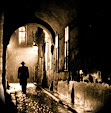
The cult comedy Withnail and I finds Richard E. Grant and Paul McGann as two debauched and unemployed actors in 1969 England who head out to the countryside to recuperate from their latest binge and get started on the next one. Broke and with few prospects as thespians, the duo manages to dupe Withnail’s (Grant) gay uncle Monty in letting them use his cottage for the week, and take off with the intention of “getting out of it” for a while. What follows is a comedy of errors and epic bad behavior, as the two insult the local townsfolk, get attacked by bulls, and go fishing with shotguns, all while consuming heroic amounts of “the finest wines available to humanity.”
Withnail and I is certainly one of the all time great films about drinking and excess, but where it works where movies like Fear and Loathing in Las Vegas fail is in the relationship between the two lead characters. There is not a false moment in the film, thanks to an eminently quotable script from writer/director Bruce Robinson (How To Get Ahead In Advertising), and brilliant performances from McGann and Grant as the two leads. Grant is as good as he’s ever been as the mercurial, cowardly, and somehow entirely likable Withnail, a ferocious ball of energy and insults that seems to have stumbled into the film straight out of a Shakespeare play. Described as a man “incapable of indulging in anything but pleasure,” Withnail is selfish, manipulative, and bombastic, and also one of the all time funniest screen characters. Scene by scene, Grant never delivers a line that isn’t pitch perfect, and he’s matched by McGann as Marwood, the “I” to his Withnail, who is the more level headed of the two, but is really only marginally less insane than his friend.
Robinson’s shooting style, as he has said himself in interviews, is pretty mediocre, but his writing is so good that you’re not likely to care. The real pleasure here (as in last year’s In Bruges, which probably owes a debt to this film) comes from watching great actors deliver great lines, and for such a small story, this works just fine. There is very little plot to be found here, just excellent characters, including Ralph Brown as the duo’s drug dealer, Danny. Brown is probably best known as the roadie Del Preston from Wayne’s World 2, and it seems that his character in that film was nothing if not a personal homage to his character here, a long-haired, philosophy-spouting hippie who makes bizarre claims like “all hairdressers are in the employment of the government” and constantly argues with Withnail over who can handle the most drugs. Richard Griffiths is also excellent as Uncle Monty, a wealthy aesthete with a penchant for food and fine wines, who shows up unexpectedly at the cottage with a single-minded obsession to seduce the hapless Marwood.
Along with the performances and great dialogue, what really makes Withnail and I so enjoyable is the theme of friendship that runs throughout. Everyone has known a person like Withnail at some point or other, and we can all identify with the neurotic Marwood. So it's easy to see how much their two personalities compliment and play off one another, and we come recognize how much each man, especially Withnail, needs the other. It’s no surprise that the film is set in 1969, at the very end of what Danny calls “the greatest decade in history,” because Withnail and I is in many ways a film about transition from one period of life to another, and the ways that certain habits and people have to be left behind in the process. The two characters spend most of the film in stasis, perpetually drunk and starving, and as that begins to change, so too does their friendship. This adds a small element of tragedy to what is otherwise a comic tale, and only helps make the film’s uncertain, bittersweet ending all the more perfect.




